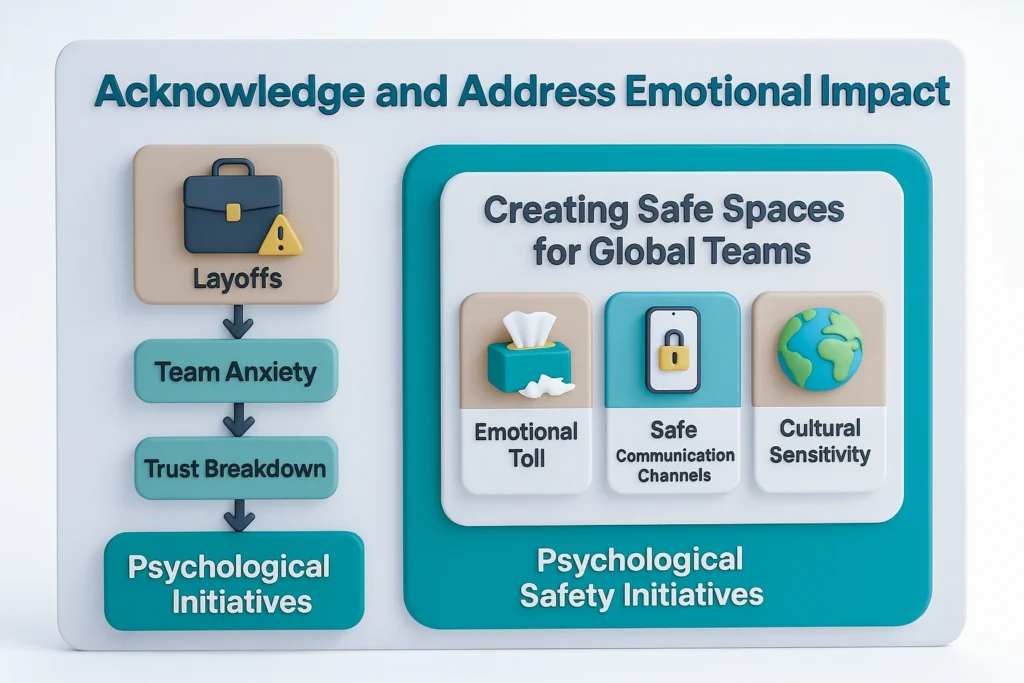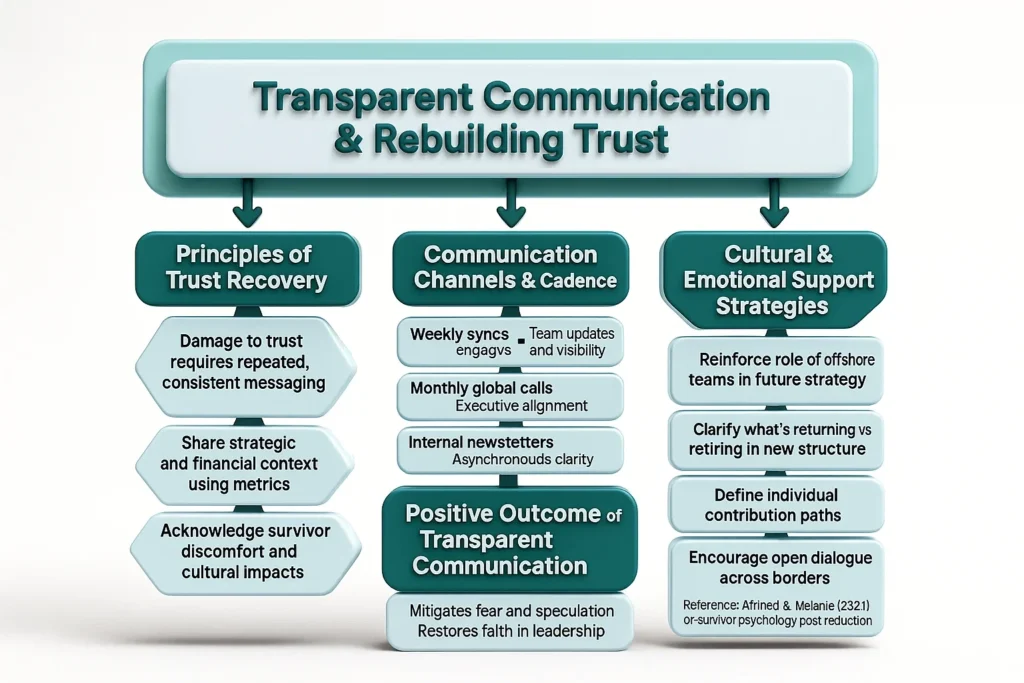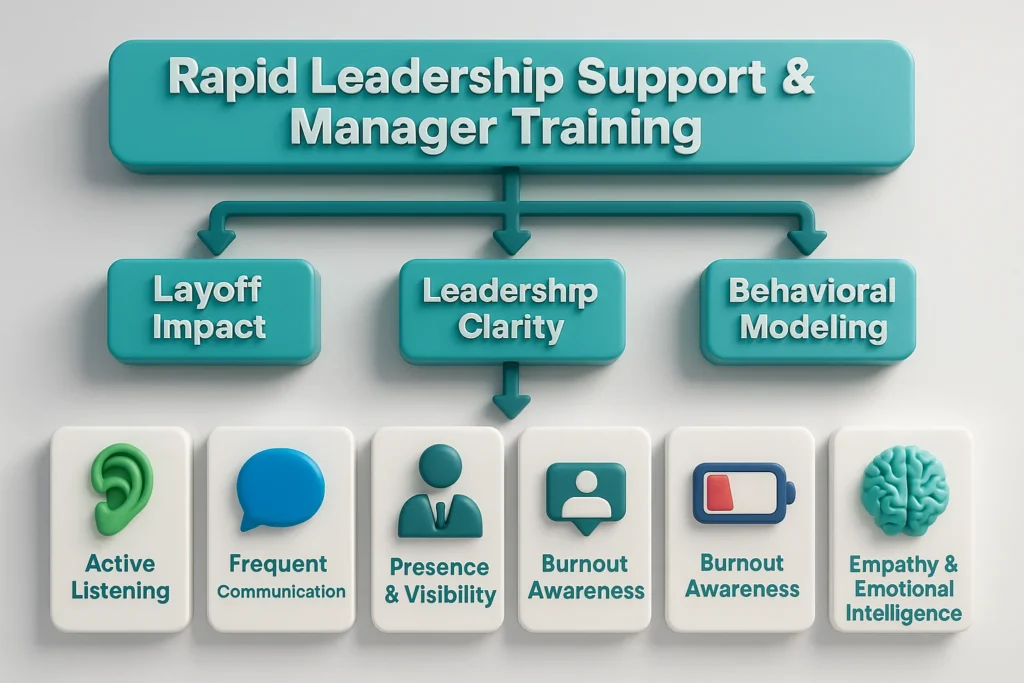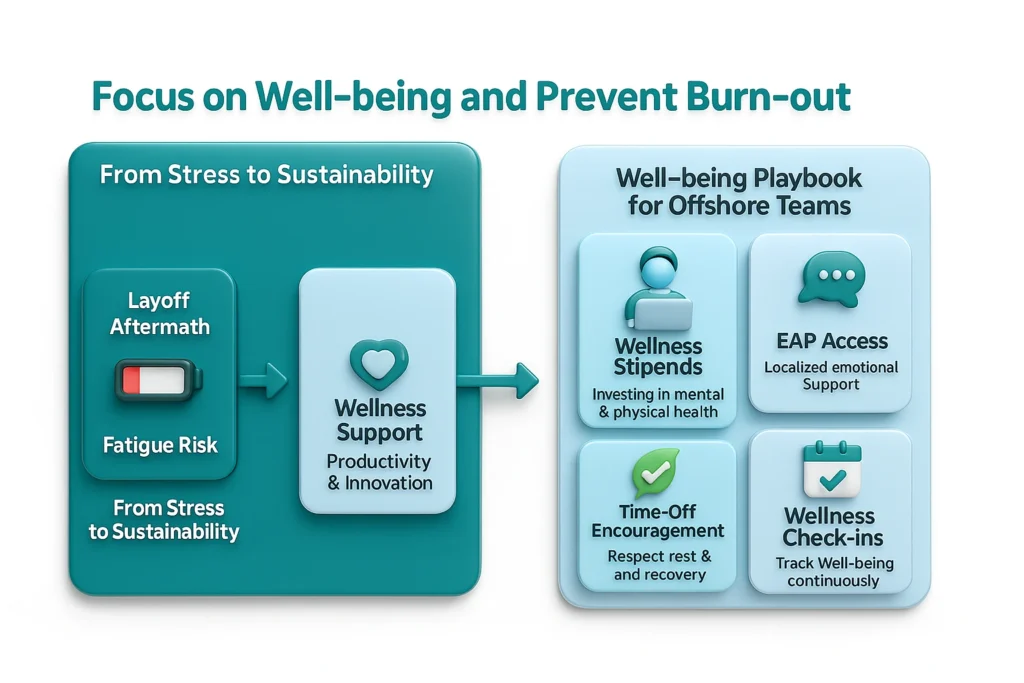The Ultimate Guide for Businesses in the Global Economy
In the era of global workforce restructuring and economic volatility, layoffs are becoming a hard reality for many organisations and companies. While focus often falls on those who exit, it is equally important to support the ones who remain and especially in distributed remote teams. Offshore teams not just carry the emotional weight of seeing their colleagues depart, but they also face the added pressure to maintain a high-class productivity amid all the uncertainties.
Rebuilding a strong and resilient offshore team post-layoffs is not just about filling the skill gaps. It is all about creating an environment of emotional stability, reinforcing trust, and also realigning team goals with agility and purpose. This process of team building after layoffs is very crucial to restore morale and momentum. Below is a complete and comprehensive guide on how to empower, stabilize and future-proof your offshore team after layoffs.

Layoffs have a very crucial and significant emotional toll, not only on the employees who are let go but also on the ones who remain. Offshore team members often have to deal with anxiety about their job security, confusion and survivor’s guilt because they remain and their colleagues are being discharged. Layoffs are not easy for staff who have been released as well as who are survivors because they have to deal with mourning situations (Wisetsri, Worakamol, et al., 2021). The impact of layoffs on surviving employees can be profound and can affect the motivation and trust within the organization.
And the key is in establishing safe, open channels for expression. Hosting virtual town halls, private 1:1 sessions, or even utilizing anonymous feedback tools allows offshore team members to express concerns and ask questions and be heard. This acknowledgement of their feelings creates psychological safety and lays groundwork for them to become re-engaged.
It’s also worth acknowledging the cross-cultural differences in how grief and anxiety are manifested among global teams. Sensitivity to local modes of communication and emotional expression promotes a genuinely inclusive mindset. When employees feel seen and heard through the filter of their culture, it strengthens their sense of psychological safety and trust.

Trust that has been damaged needs repeated and consistent communication to repair. Begin by describing why the layoffs are necessary, supported by business metrics and context. From my own personal experiences, I’ve found that when a company is open about its strategic direction and financial health, it can temper fear and speculation. According to some researchers and scholars, it is essential to understand why survivors of workforce reduction usually tends to react in a negative way to the positive outcome for the employees that are retained, in order to develop the guidelines for ensuring a positive environment by creating a productive and positive post layoff culture (Ahmad & Melanie, 2021)
This ensures the team is kept informed and included, whether it be through weekly syncs, monthly global calls, or internal newsletters. With transparent and proactive communication, offshore teams are made to feel part of leadership and better understand the direction and path the company is pursuing.
Transparency should go beyond the tactical nuts and bolts, and the future must also be revealed. Offshore staff should know what success will be in the new structure, what will come back, what won’t be coming back, and how they will contribute productively going forward. Once information starts flowing freely, faith is gradually restored.

After the layoffs, the workload for surviving workers frequently increases. But slapping tasks on without forethought causes burnout, resentment, and under performance. Step back and think you’ll react a bit more calmly and assess team capacity, re-evaluate project priorities, and delegate tasks according to people’s strengths. As per researchers, survivors are often worried about their personal job securities and sometimes there can be anger associated with the process due to which the redundancy programmes are implemented and sometimes there may be some concerns regarding the creation of heavier workloads because of the reduced manpower (Campbell-Jamison, Fiona, Les Worrall, and Cary Cooper, 2001)
Adjust the goals to the size and shape of the restructured team. Be open about what’s changing and why, and try to include the offshore team in the planning process. If people can understand and take part in how work is reimagined, they are more likely to be engaged and motivated.
Workload management tools such as Asana or Jira can be useful here to help visualize the distribution and prevent bottlenecks. Creating shared team dashboards also adds clarity and removes time zone friction.

It is a time for strong, empathetic leadership. Arm your managers to deal with the emotional fallout of layoffs with clarity and compassion. That includes how to lead with empathy, manage remote teams, and have challenging conversations.
Managers should model the behavior — being present, communicating often, and listening well. With the offshore employees, seeing such responsive and emotionally intelligent leadership, they are more likely to persevere and stay committed even through the disruption.
Management also needs to be trained to identify early signs of burnout or disconnection, especially in a remote environment that does not provide non-verbal clues. A small investment in the leadership capability of frontline managers secures the resilience, which is modelled and sustained across the organisation.
When workers are laid off, it’s natural to ask whether their work matters. This disconnect can be even more intense for offshore teams, with their physical and cultural separation from headquarters. It’s important to underscore the company’s mission and how each person’s role plays into it.
Real client success stories, progress figures, or worldwide video calls that show the continued traction of the team’s work. When offshore workers can see the difference they are making, they feel more valued and are more engaged by the company’s direction.
Regular storytelling, leader-led vision sessions, and culture sharing times, however, can refresh the sense of purpose. Employees need to know the company is not only surviving but thriving, and that their input is a vital part of that thriving.
Team spirit is one of the first things to go after layoffs. In offshore teams, especially, they may be isolated and feel neglected. To counter this, schedule in some intentional bonding experiences that build ‘interpersonal network’, that cream of trust.
These may be invitations to culturally affirming team-facilitation activities, casual virtual meet-ups, or co-working sessions around innovation or problem solving. Restoring social cohesion is a good means to keep up morale and foster a climate of mutual aid and solidarity.
More durable programmes such as internal mentorship, buddy systems for new work, and interest groups can build even stronger connections and resilience across the team. Team rebuilding requires sustained effort, but the trust and coöperation it engenders is powerful.

Stay-behind team members are often called upon to step up, so it’s important to reward those who do for real. This may be in the form of increased responsibilities, internal promotions, or taking ownership of new projects.
Skills development, such as access to digital learning platforms, mentorship programs, or cross-functional projects, not only demonstrates gratitude but also grooms your offshore team members for the future. Investing in development is a commitment and an employee retention driver.
It also reduces the exposure of a single point of failure, as employees have increasing cross-functional and multitasking abilities. Certifications, knowledge sharing sessions, and leadership tracks offer growth from within.

A tough team is one that feels safe to take risks, acknowledge mistakes, and innovate without reprisal. Establish an atmosphere in which learning and experimentation are valued. Celebrate movement and progress, no matter how incremental, and remind them that perfection isn’t the end goal — growth is.
Introduce initiatives like peer support groups, buddy systems, or resilience training. These are tools to help offshore teams develop emotional endurance and camaraderie even under pressure.
And a culture of psychological safety can be nurtured through inclusive policies, good listening, and transparent feedback loops. A strong culture gives team members the ability not just to bounce back from setbacks, but to bounce forward, learning and changing as they go.
Agile methodologies provide a tested model for flexibility and effectiveness—a precious resource following organizational modifications. Adopt Agile ceremonies like stand-ups, sprint reviews, and retrospectives to keep up the pace and stay on course.
Cross-training workers fills the vacuum when people leave, and allows team members to assist one another when the work ebbs and flows. For the offshore teams, this makes them more flexible and enables better overall collaboration irrespective of the time zones and functions.
Shared documentation, digital kanban boards, and ongoing backlog grooming make it easier to gain clarity and control of the process without needing to rely on any one individual. Agile is about ownership, autonomy, and collective problem solving — all critical characteristics of the rebuilding phase that follows a layoff.

Layoff survivors, after all, can wind up overdoing out of guilt or because of fear. Effort will increase, but not at the cost of health. Encourage and maintain good work-life balance in the context of offshore time zones and watch for fatigue or demotivation.
Provide support through wellness stipends, localized employee assistance programs (EAPs), or flexible scheduling policies. Supporting rest and balance is not something we do only if we are “lucky” enough to be in an industry with enough resources to afford indulging in institutional indulgence — it’s a central tool for building long-term performance and morale.
Roll out wellness check-ins, mental health awareness campaigns and time-off encouragement that are adjusted for local needs. Offshore colleagues that are supported in mind and body are far more likely to remain engaged, productive and innovative.

Recovery isn’t about returning to how things were; it’s about moving forward. Re-form your UK offshore model around scale and futurability. Feed employee and customer input in continuous improvement loops. Eliminate wasted time by automating the most time-consuming processes. Organizational layoffs are actually designed to enhance the economic outlook, productivity and overall competitiveness and often they are perceived as the only way to safeguard the organizations from bankruptcy (Mujtaba, Bahaudin G, and Tipakorn Senathip, 2020)
As you grow back up, scale with intent. Create efficient, effective and engaging roles and processes that contribute to long-term business objectives. A leaner team doesn’t have to be a weaker one — if rebuilt from scratch in an agile, innovative manner, it can be stronger and more productive than ever.
Create an experimentation culture, tap into ideas from all levels of your organization, and incorporate feedback mechanisms that cycle into your planning. Let your global team see that they get to play a part in creating the future. As part of broader discussions on US outsourcing jobs, it is very crucial to ensure your team overseas feels as integral as those onshore.
Layoffs are painful but come with an opportunity, too: to rebuild smarter, stronger, more purposely. Empathy, clarity, vision, given these ingredients, offshore teams can come through disruption with renewed vigour and resilience.
For those personally affected, offering layoff support and advise to give to someone who was fired can also play a vital role in healing and reputation. As the remaining team rebuilds, remember that employee engagement after layoffs is the cornerstone of sustainable growth.
Q: How to deal with a layoff?
A: Take time to process emotionally, review your benefits, update your resume, and focus on networking or upskilling. Treat it as a transition, not a failure.
Q: How are laid-off employees being supported during this transition?
A: Support often includes severance packages, extended healthcare, job placement assistance, emotional support resources, and transparent communication from HR.
Q: What are team building activities after layoffs?
A: Virtual coffee chats, team retrospectives, workshops, wellness challenges, and cross-functional collaboration projects help rebuild trust and connection.
Q: How to motivate a team after firing someone?
A: Communicate openly about the change, show empathy, refocus the team on shared goals, and involve them in forward-looking planning to restore momentum.
Q: How to build morale after layoffs?
A: Boost morale by recognizing remaining team members, reinforcing the company’s mission, encouraging open dialogue, and offering growth opportunities.
Wisetsri, Worakamol, et al. “The effect of layoffs on the performance of survivors at healthcare organizations.” (2021): 5574-5593.
Ahmad, Melanie. “The onshore impact of offshoring: Supporting and preserving work motivation and employee well-being.” (2021).
Campbell-Jamison, Fiona, Les Worrall, and Cary Cooper. “Downsizing in Britain and its effects on survivors and their organizations.” Anxiety, Stress and Coping 14.1 (2001): 35-58.
Mujtaba, Bahaudin G., and Tipakorn Senathip. “Layoffs and downsizing implications for the leadership role of human resources.” Journal of Service Science and Management 13.02 (2020): 209.
Join thousands of businesses leveraging offshore staffing to scale their operations globally
Expand effortlessly with My Offshore Employees - access top 1% offshore talent starting at just $3/hr or $600/month per FTE. No hidden fees, no compromises on quality. Your offshore employees work exclusively for you - ensuring focus, transparency, and real-time visibility into your projects. We combine smart automation and proven industry experience to deliver higher productivity, fewer errors, and tailor-made solutions for your business growth.
© 2025. All Rights Reserved.